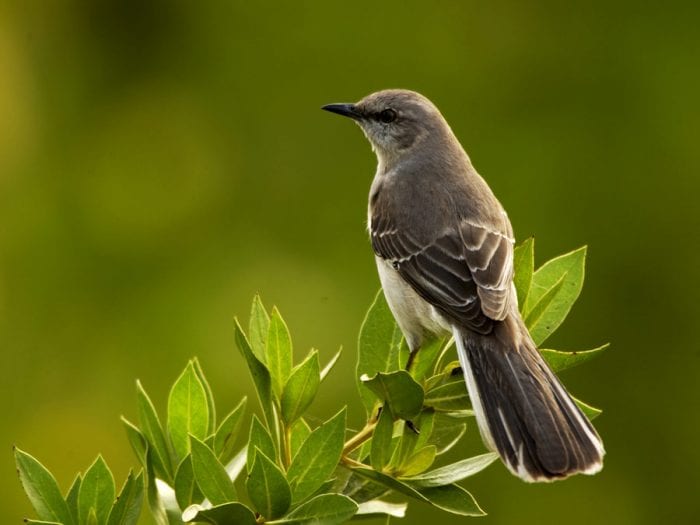By John L. Turner
A fact about living in suburbia is the presence of neighbors and we are blessed in having a bunch of wonderful neighbors in the Setauket neighborhood in which we live.
Lately though, I have become aware of, and begun to appreciate, another set of neighbors: those of the feathered kind. We are neighbors to the birds and this spring I’ve watched families of birds, going about their lives, amidst our property and that of some of our neighbors. Our human properties are embedded within the “properties” in which they nest.
In a side shrub a pair of Song Sparrows made a nest while in a front yard shrub it was a Robin. On an eye-level branch of a Norway Spruce located along a boundary of the backyard I watched a pair of Mourning Doves raise a pair of young that successfully fledged, and further back in a blackberry bramble was a Catbird nest.
We also routinely see several woodpeckers species feeding in the yard and have Carolina Wrens, Northern Cardinals, Black-capped Chickadees, for whom our property is a cafeteria. Most recently, we’ve been witness to a family of Screech Owls — two parents and three young — as they have begun, on silent wings, to expand their world.
But the most conspicuous neighbor of all has been a pair of Northern Mockingbirds. I haven’t located their nest but our property along with the neighbors that flank each side are within the pair’s territory as evidenced by the trees the male alternates flying to and singing from the tops of.
And, wow, do Mockingbirds sing. They are most well-known for “mocking” or copying the songs of other songbirds, with some birds having a repertoire of several dozen songs absconded from others. In total, Mockingbirds can sing hundreds of different phrases — a combination of unique calls interspersed with the mimicked songs of others.
About a month ago the male sat atop a tall Spruce tree along my northern border and enthusiastically sang continuously for 20 minutes. In his long song sequence I discerned songs that included the Eastern Phoebe, Northern Cardinal, Carolina Wren, Killdeer, Great Crested Flycatcher and two different Blue Jay calls. On several occasions it quacked like a duck! (Many years ago I heard a Mockingbird singing along the edge of a field in Hauppauge making a sound that sounded exactly like a car alarm!! I wouldn’t have believed it if I didn’t directly witness the sound emanating from the open and moving bill of the bird).
Their scientific name — Mimus polyglottis — literally means “many throated mimic,” an obvious reference to their ability to sing other bird songs.
That the Northern Mockingbird is a feathered virtuoso has long been recognized by professional ornithologists and curious naturalists alike. J.P. Giraud in his seminal 1842 work “The Birds of Long Island” noted: “It is the nightingale of America, and according to those who have heard the native notes of both, its voice, both in variety and fullness, is superior to that of Europe’s sweetest songster. Its power of imitation is so great, that this highly gifted bird runs over the varied notes of all our songsters, and executes with so much skill, that it would seem as if Nature had so attuned its voice that it might exceed all of the feather choir.”
Frank Chapman, the longtime curator of Ornithology at the American Museum of Natural History, and the father of the National Audubon Society’s Annual Christmas Bird Count, wrote: “The Mockingbird might be called our national song-bird; his remarkable vocal powers have made him famous the world over … He is a good citizen, and courting rather than shunning public life, shows an evident interest in the affairs of the day. He lives in our gardens, parks, and squares, and even in the streets of the town …” and in regard to his singing Chapman notes: “… if his song does not thrill you then confess yourself deaf to Nature’s voices.” — an opinionated but accurate statement if their boisterous singing fails to put a smile on your face!
But why is it that Mockingbirds, a rarity among songbirds in singing the songs of other birds, evolved this fascinating behavior of vocal mimicry? For the same reasons that other male birds sing — to defend a breeding territory and attract a mate. They’ve just taken it to a new level driven by the fact that females are apparently attracted to males with larger song repertoires.
This new level includes singing at night, especially on nights when the moon is strong. While I’ve not yet heard “our” birds singing at night, I had night singing Mockingbirds routinely while I lived for many years in Massapequa Park and before that during my childhood in Smithtown.
Mockingbirds are related to two other songbird species native to Long Island with which you might be familiar: the Gray Catbird and the Brown Thrasher. All three belong to the family Mimidae, the Mimic Thrushes, and they all mimic other birds, although the Mockingbird stands alone in its skill.
With a little bit of effort you can see them. The Brown Thrasher prefers wilder habitat. It is a fairly common breeding bird in the vast expanses of the Pine Barrens, where it prefers to lurk about in the understory while Catbirds and Mockingbirds frequent the suburban habitat around your home.
If you have a Mockingbird as a neighbor, perhaps the “Many-throated Mimic” will grace you with his night-time serenade on a moonlit night.
A resident of Setauket, John Turner is conservation chair of the Four Harbors Audubon Society, author of “Exploring the Other Island: A Seasonal Nature Guide to Long Island” and president of Alula Birding & Natural History Tours.





